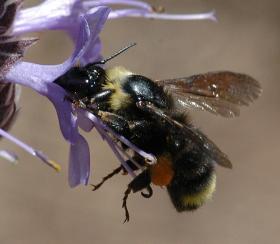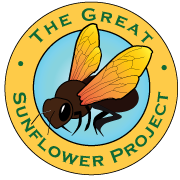
Folks, 
We hope you are enjoying this summer season. We encourage everyone to make pollinator counts throughout the summer on as many plants as possible – even those that are not attracting pollinators. We’d like to make regional maps of the best and worst species of plants for attracting pollinators and the information you gather will help us immensely. To help, do a pollinator count or two on each of the plants in your garden or in a local park and let us know what you observe. Our goal is to create a regional guide to key resources for different pollinators. In my own observations I’ve been surprised to see that bees frequent pink Farewell-to-Spring (Clarkia amoena) in my northern California garden. I usually associate flowers of pink and red with hummingbirds instead of bees! Our collective observations help move scientific understanding forward, please keep counting!
In this newsletter we are profiling Bumble bees in the genus Bombus. Bumble bees are some of the most charismatic native bees in North America. They are fuzzy black and yellow bees (though some have orange on them) and are hairy all over their bodies as opposed to carpenter bees who have only a few sparse hairs on their abdomens. The varied color patterns usually indicate different species, but in some types of bumble bees the male has a different coloration than the queens and workers. Most of the bees you see exploring your flowers are female workers or the queen. They are the only ones who gather pollen on their hind legs to take back to the nest for the larvae to eat. Males spend their time drinking nectar and looking for mates.
Bumble bees can be as tiny as the nail on your pinky or as big as your thumbnail and often differently sized bees are the same species! In a colony, the queen is the largest bumble bee. The queen is typically seen in early spring when she emerges from the ground after winter, establishes her nest and raises the first set of worker bees. Once these first worker bees have hatched, the queen spends the rest of her life producing eggs and never again leaves the nest. Most of the bees we see are workers who are female. Workers and males are smaller than the queen and the size of the worker varies according to the amount of food that was available during her development. Males are usually only produced at the end of the season as the life of the nest comes to an end. As the summer ends and resources begin to decrease, the colony will produce male bees and new queens. These bees will mate, the males will die, and the new queens will overwinter in a small underground tunnel, to emerge the next year and start the cycle again.
So, how can you help Bumble bees thrive? These intriguing creatures have been well studied and we know that some species are experiencing significant declines. You can help by avoiding pesticides, planting natives and maintaining an abundance of flowers from spring to late summer. Bumble bees are attracted to blue, yellow and white flowers and studies show that they prefer perennials. They primarily nest in the ground though a few species nest in above ground cavities and can be opportunistic. (We discovered a colony nesting in a bluebird box!) Set aside some areas in your garden that are protected from mowing, burning, digging and other types of disturbance to protect nests and overwintering queens. For suggestions on how you may improve your garden habitat for pollinators take the Great Habitat Challenge. It is available by clicking this link: My Garden link.
Thanks for all you do for pollinators.
Bee well,
Gretchen
The Queen Bee
